Week 5. Glycogen Storage, Depletion, and Repletion
1. Where are Carbohydrates Stored in the Body, and How Much is Stored?
Where are Carbohydrates Stored in the Body, and How Much is Stored?
MUSCLES of MEN and WOMEN: Men and women store carbohydrates – renamed glycogen – primarily in muscles.
On a so-called normal carb diet (CHO diet) a woman stores almost 300g total glycogen in her body and a man stores 400g total.
LIVER: The liver is like a spare gasoline tank for the body to store carbs; it stores approximately 50g glycogen in both men and women.
- The main reason for storing glycogen in muscles is for when you exercise hard – your muscles cells have stored fuel on-site – so there is no delay to deliver fuel and sustain high intensity exercise.
HOW IS GLYCOGEN MADE IN THE BODY?
Most dietary carbohydrates break down into glucose in your gut. After passing into your bloodstream this glucose is quickly uptaken into skeletal muscles and liver and reconnected together as glycogen. Glycogen is just another form of complex or starchy carbohydrate – made of individual glucose units connected and packed together in lumped up chains.
Starchy carbohydrates and glycogen look virtually identical; both are individual units of glucose strung together.
Since glycogen and dietary carbohydrate are essentially the same thing – we can instantly calculate total calories of glycogen stored in the body the exact same we do in food.
For example:
- A woman may store almost 300g of glycogen as shown in the graph. Carbohydrate has 4cal/g.
- 300g x 4cal/g = 1200 calories of total carbohydrate stored in her body.
The next graph shows the absorption rate of glucose as it leaves your gut and enters your blood stream, which raises blood sugar. I call this the ‘Sugar Effect’ to make it memorable.
Notice the blue flat line:
It shows pure sugar or glucose will NOT increase your blood sugar level when mixed with certain foods. In the case shown, beef is used to avoid the Sugar Effect – which is the quick increase of blood sugar caused by eating just sugar alone (or many types of complex carbohydrates) not mixed with protein and/or fat.
First challenge to the assumption ‘Sugar is Bad’:
- Fat and protein eaten with pure sugar will slow the absorption rate of glucose effectively.
- You do not absolutely have to avoid sugar to be ‘healthy’ or avoid insulin spikes.
Special remarks: The Case Against Sugar, by Gary Taubes was just released Dec, 2016. Exposing the cover up by scientists and agribusiness is actually old news, but not for the masses. There are two more challenges to ‘sugar is bad’ in this course. These challenges expose reactive thinking and/or an incomplete understanding of nutritional physiology. The wise person learns the cases ‘when sugar is needed and why’. In short, there are cases for sugar.
Keeping a skeptical mind means you investigate before reaching judgements and conclusions. The words ‘good’ and ‘bad’ should be avoided when explaining principles of exercise science and nutrition.
COMPARE DIETS:
Eating a higher carb diet results in more glycogen stored in muscles compared to a low carb diet. But you must exercise regularly for this to happen. People who do not exercise will not store more glycogen in their muscles.
2. Depletion of Carbs
EXERCISE INTENSITY DETERMINES GLYCOGEN DEPLETION
Imagine intensity in terms how it feels:
- Rest
- Light to Moderately High Intensity
- Very High Intensity
- Absolute maximum speeds or workloads like 1 rep-max lifts or sprinting a 100m dash.
The next section Repletion of Carbs demonstrates what type of exercise causes the highest amount of glycogen depletion and how to fully replete glycogen levels afterwards.
3. Repletion of Carbs
Repletion of Carbs
This graph shows the quickest depletion of glycogen possible. The study required elite cyclists to exercise very intensely for 2 straight hours.
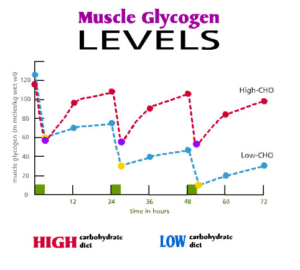 The red line and blue line represent 2 separate groups of elite cyclists. The steep descending slopes of the red and blue lines show an extremely quick and virtually identical quantity of glycogen depletion in each group. Another 2-hour bout was repeated 24 hours later, as well as a 3rd bout 24 hours later.
The red line and blue line represent 2 separate groups of elite cyclists. The steep descending slopes of the red and blue lines show an extremely quick and virtually identical quantity of glycogen depletion in each group. Another 2-hour bout was repeated 24 hours later, as well as a 3rd bout 24 hours later.
Within 24 hours of each bout, only the red group repleted glycogen stores almost to their original levels.
- The cyclists were matched as to their energy requirements. They each consumed a 3,500 calorie diet that was either low in carbohydrate (40% of total calories, 300-350 grams of carbohydrate daily) or high in carbohydrate (70% of total calories, 500-600 grams of carbohydrate daily.)
Full glycogen repletion occurs in 2 phases.
PHASE 1 – Insulin Dependent Phase. Circled on the graph.
- Restocking glycogen after extreme depletion is primarily dependent on ingesting extremely high amounts of simple sugars immediately after training in a typical post recovery meal or drink (sugars + protein, no fat). High sugar intake increases the hormone insulin, which in turn speeds up restocking glycogen into the muscle quickly. Thus, we see a steeper rise in the graph in phase 1. and and enzyme called glycogen synthase
PHASE 2 – Non-Insulin Dependent Phase. Arrow points to this phase.
- High sugar intake and spiking insulin is not needed to ‘finish restocking’ glycogen levels. Full restocking now requires eating plenty of starchy or low glycemic type carbs – but in a few ‘normal meals’ – combined with protein and fat.
Summary of Muscle Glycogen Repletion
Repeating extreme performances day to day requires ‘forcing repletion’ – consciously in two phases – beginning with high sugar intake.
Phase 1 is obviously the more important of the two phases since the majority of replenishment occurs then.
The blue group cyclists not only failed to refill their glycogen stores compared to the red group, but suffered from a progressive drop toward almost complete depletion after the third bout. The reason for the difference is simply because the blue group cyclists were fed an inadequate amount of carbohydrates after each bout compared to the red group.
On Liver Glycogen Repletion:
The types of carbs eaten determine full glycogen repletion (synthesis) in the liver. We’ll talk about the differences in carbohydrates in class later. For now, you can see the effect different types of carbs have on liver glycogen repletion.
Special Video: Baboon Eating a Gazelle Alive
4. Storing Glucose and Converting it. The Glucose – Muscle – Liver Connection
Storing Glucose and Converting it. The Glucose – Muscle – Liver Connection
STORAGE OF GLUCOSE: Very little glucose is stored in blood. There is only 4-5 grams in 5 liters blood. (Numbers on the left are grams and figures on the right are calories) 
It’s amazing to realize a human can eat 100g of glucose and a ‘healthy’ body will quickly get the glucose out of your blood and keep only 4-5 grams as its ‘preferred sugar load’. (see glucose tolerance test)
Your body NEVER wants high glucose in blood. A healthy body strives to store practically ALL dietary carbohydrates as glycogen in the liver and muscles.
LIVER GLYCOGEN
Liver glycogen is not used to power muscles. Instead, the liver provides a ‘slow drip’ of glucose into your bloodstream by breaking glycogen back into glucose units. If you do not eat carbs for awhile, say 5 hours, your liver’s drip-supply of glucose keeps your blood sugar steady at the 4-5 gram level. Thus, your liver slowly depletes when you do not eat carbs.
It is necessary to keep glucose levels steady at all times – especially during exercise, as described next.
MUSCLES ‘suck’ glucose out of the bloodstream during intense exercise, which lowers blood sugar. So the liver responds by releasing glucose into the bloodstream to prevent a drop and keep blood sugar levels steady.
- Exercise help diabetics lower their elevated blood sugar levels simply because working muscles take up glucose from the blood.
- The reason some people may feel light headed during intense exercise or from sudden strong emotional stress/anxiety – can be caused by a quick drop of blood sugar due to muscles ‘sucking’ glucose in or the brain’s sudden demand on glucose during intense anxiety/stress. Sugar itself – taken in small amounts – can reduce stress. I’ll talk more on this in another lecture.
The moment glucose is sucked into a muscle cell – two possible fates await glucose:
1. Glucose is reconnected together and stored as glycogen. This happens at rest – and is quickest during Phase 1 immediately after exercise.
2. Glucose is utilized as fuel during exercise.
Muscle cells utilize glucose – not glycogen – as fuel substrate.
Muscle glycogen break downs into individual units of glucose either slowly or quickly dependent on intensity level. Muscle glycogen is just a rich source of glucose stored by muscle cells.
Here’s another look at glucose connected/packed into glycogen.
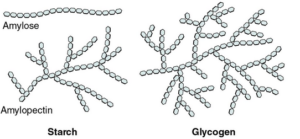 The longer and harder you exercise the less glycogen is available to feed muscles. Both muscles and liver may be wiped out. This is why long distance runners and cyclists may sip on simple-sugar formulated sport drinks or eat ‘crappy’ simple carbs such as donuts.
The longer and harder you exercise the less glycogen is available to feed muscles. Both muscles and liver may be wiped out. This is why long distance runners and cyclists may sip on simple-sugar formulated sport drinks or eat ‘crappy’ simple carbs such as donuts.
YOUR BRAIN/BODY senses the ‘drain’ on blood sugar during exercise (and at rest). The liver responds to the drain by releasing glucose to feed muscles ‘sugar loaded’ blood. Keep in mind, other active tissues/cells like the brain and organs need glucose too, thus the liver maintains a steady level by releasing glucose into the blood.
THOUGHT EXPERIMENT / demonstration with Macroman. What may happen to carbohydrates eaten in an ‘excessive amount’ – say 700g in a day, which overfill your glycogen storage capacity?
5. Readings
- Optimum Performance With Proper Hydration
- Understanding Bodyweight and Glycogen Depletion
- Glycogen Replenishment after exhaustive Exercise
- Glycogen Supercompensation
- Depletion Workouts
Optional Advanced Readings
Props:
Macroman
Einstein’s Muscle

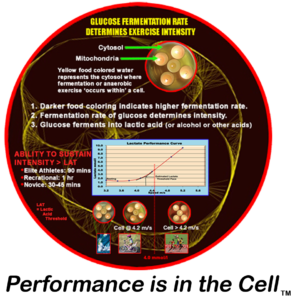
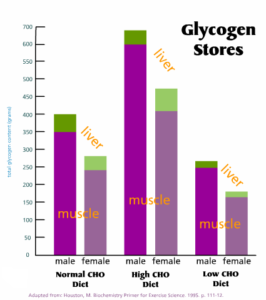
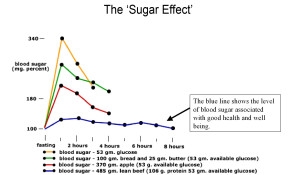
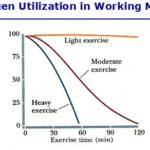
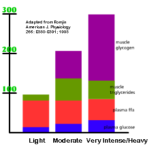
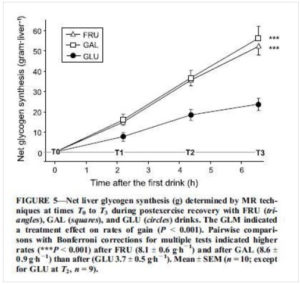
Whoa lots of valuable info. https://bucketlist.org/idea/6LiG/ideas-to-assist-properly-deal-with-nervousness/
Many thanks. Very good stuff! https://bucketlist.org/idea/6LiG/ideas-to-assist-properly-deal-with-nervousness/